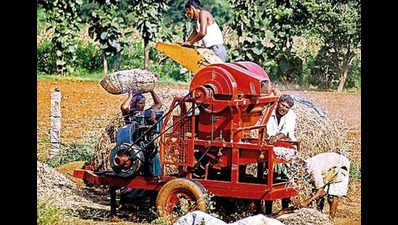Farmers in Maharashtra’s Soya Bean Heartland Struggle with Low Prices and Rising Debt | – Times of India


When monsoon kept its date this season, an overjoyed Sandipan Kutwade sowed soya bean seeds in his four-acre plot with high hopes. But the Latur farmer’s hopes turned into despair when he took his crop to the market. After covering costs of Rs 83,900, all he could get was a profit of Rs 13,940 on 20 quintals of produce. The meagre return could barely stretch for six months before his next yield. How would he sustain his family of five? How would he repay his loan? Even then, this was Kutwade’s best-case scenario – the profit he made was the result of a minimum support price (MSP) of Rs 4,892 per quintal.
At campaign rallies across Marathwada, the state’s soya bean heartland, speeches from opposition leaders are replete with condemnation over what they call the “govt’s betrayal” in securing fair prices, while those in power underscore the introduction of MSP as evidence of their farmer-centric effort. Kutwade said farmers’ frustration will echo in the polls. “We are angry. For three years, we hoped prices would improve, but no. We do not want handouts disguised as govt schemes. They put a price on us just to win votes. We need a fair price for our crop, affordable education for our children, and decent govt hospitals within reach.”
Trader Ramesh Suryavanshi said his fraternity too incurs losses as they are forced to sell stored soya beans — purchased two years ago in hopes of a price rise — at much lower rates. “Back in 2018-19, prices ranged from Rs 7,000 to Rs 10,000 per quintal. The rates then plummeted.” Prices depend on a quality standard known as ‘10-2-2′, meaning 10% moisture, 2% damaged grains, and 2% foreign material, he said. “A crop meeting this standard fetches the highest rate. But during Diwali and even now, soya beans arrive with over 16% moisture, so prices are considerably lower.”
Soya beans cover over 50 lakh hectares (more than under cotton and sugar cane farming) and the season’s anticipated yield of 73 lakh tons at a productivity rate of 14.5 quintals per hectare reveal a sector battling stagnation. In Sept, the Centre declared an MSP of Rs 4,892 per quintal, but it took more than two months for state-appointed procurement centres to get operational. For instance, the one in Latur city, managed by Jagruti Pragati Bijotpadan Prakriya Sahakari Sangh, began accepting produce on Nov 7. “We operate as agents for the National Cooperative Agricultural Federation (NAFED),” said Laxman Uphade, the centre’s purchase officer.
Not all farmers can meet the specifications for quality prescribed by the procurement centre (12-3-2), forcing them to sell at APMCs. On Wednesday, the auction at Latur APMC saw the highest price reach Rs 4,232, with the lowest at Rs 3,950. Trader Gundappa Malwade said pre-Diwali arrivals had moisture levels touching 25%. “With that much content, farmers cannot hold on to their produce, as it starts developing fungus in 15-20 days. They were forced to sell at just Rs 3,600.”
Of the eight Lok Sabha seats in Marathwada, MVA won seven in the 2024 polls. BJP lost all four seats it contested, while Congress won all three it fought. Mahayuti partner Shiv Sena secured the lone exception in Aurangabad. Some analysts suggest these results were influenced by the Maratha reservation issue, while others point to farmers’ woes. This assembly election, Marathwada’s 46 assembly seats include seven districts that ate among the largest soybean producers in Maharashtra, alongside Buldhana, Akola, Washim, Yavatmal, and Amravati in Vidarbha.
Farmers are beginning to question whether it’s time to switch to different crops. Yuvraj Patil, a soya bean farmer, claims nearly every farmer has borrowed heavily—either from banks or local moneylenders—hoping they could repay once they sold their harvest. Patil himself is weighed down by a Rs 2 lakh loan and is on the brink of selling his land. “People are already selling their land just to pay off the moneylenders,” he said. “I would never allow my children to enter agriculture. I cannot sleep at night thinking about their future. If we are suffering like this, what hope do they have? I regret ever stepping into farming. Last year, I sold part of my land to settle a debt. If we keep selling off our land year after year, what will we have left? How will we even put food on the table? The govt is to blame for our plight.”















